Exploring Marine Pennant Flags: A Comprehensive Guide


Intro
In the vast and varied world of marine activities, few symbols resonate as deeply as pennant flags. These colorful pieces of fabric are not mere decorations; they hold rich histories and intricate meanings woven into their very fibers. Notably, in surfing communities, marine pennant flags enhance communication, promote safety, and foster a distinct culture that values both the thrill of riding the waves and the traditions that bind surfers together.
As we sail through this guide, we will explore the historical significance of these flags, going back to when they first adorned the masts of ships and even today’s surfboards. By dissecting their design variations, readers will uncover the distinctive characteristics that differentiate each pennant. Beyond aesthetics, marine pennants serve crucial roles in signaling especially in the context of surfboarding, which emphasizes communication among surfers and between beachgoers.
Moreover, we will delve into the symbolism that underpins various flags, some of which might seem straightforward at first glance, but hold deeper meanings upon closer inspection. The regulations governing their displays are also worth understanding, especially for those who wish to embody the spirit of maritime practices responsibly.
In addition to these historical and practical aspects, we will highlight the cultural relevance of marine flags within surf communities. From casual beach gatherings to competitive events, these flags not only signify norms and warnings but also enhance the overall surfing experience by connecting individuals to the deeper maritime traditions they cherish.
By the end of this journey, readers will grasp the synergy between marine pennant flags and surf culture, enabling them to appreciate these flags as more than just visuals but as vital tools in the narrative of surfing.
Let’s hoist the sails and get started on this fascinating exploration!
Prologue to Marine Pennant Flags
The world of marine pennant flags is a fascinating one, saturated with history and practical communication methods that directly impact not only maritime operations but also surfboarding culture. To understand the importance of these flags, one must appreciate their roles both as symbols and as functional tools in diverse water activities.
Defining Marine Pennant Flags
Marine pennant flags are specialized flags used on watercraft to convey specific messages regarding navigation, safety, and designation. These flags have a unique design that helps distinguish them from standard flags, incorporating distinctive geometric shapes and colors. Mariners utilize them, as they are vital for communication amidst the vast and often unpredictable ocean landscape. The clarity and immediacy of these flags ensure that crucial information can be shared without heavy reliance on technology, which might falter due to environmental conditions.
Historical Context
Origins of Maritime Signaling
The roots of maritime signaling can be traced back centuries when visual communication became essential for seafaring. In those early days, sailors quickly recognized the need to convey messages over vast distances. Thus, they adopted a variety of signaling methods, starting from simple shapes and colors made from cloth to elaborate designs that evolved over time. The key characteristic of these early signals was their straightforwardness, designed to ensure messages could be understood without confusion or misinterpretation.
This simplicity made them a popular choice among early mariners, allowing them to communicate critical information swiftly. The unique feature of these early signaling methods was their adaptability to varying conditions of visibility, enabling effective communication day and night. However, the challenge lay in devising a common understanding between different cultures, which further shaped the development of marine flags.
Evolution of Flag Designs
As maritime activities expanded globally, so did the complexity of flag designs. The evolution of flag designs reflects not just a change in aesthetic preferences but also an increasing need for more sophisticated communication systems. In the 19th century, various nations established standardized designs to enhance international communication and avoid misunderstandings during navigation. This standardization process was crucial for establishing the International Code of Signals.
A notable feature of this evolution is the introduction of color psychology and symbolism into design choices—each hue bearing specific meanings. This transition was beneficial for unifying communication not only among sailors but also among different cultures. Nevertheless, while standardized designs fostered clearer communication, they sometimes overlooked localized traditions, which continue to influence flag variations today. Along with this, the rise of digital communication presents modern challenges and advantages for understanding these historical designs in a contemporary context.
In summary, the significance of marine pennant flags stretches from their original signaling utility to their deeper cultural implications in today's surf culture. As we strive to uncover the stories behind these versatile flags, we realize their role extends far beyond mere fabric tossed into the wind.
Types of Marine Pennant Flags
Marine pennant flags serve as essential tools in the maritime community, especially in the realm of surfboarding. Understanding the different types of pennant flags is crucial, as they not only facilitate communication but also enhance safety and organization in various aquatic activities. From signaling emergencies to providing information during competitions, the importance of these flags cannot be overstated. The diversity among signal flags and racing pennants reflects their specialized roles in both casual surf culture and competitive events.
Signal Flags
Purpose and Functionality
Signal flags are the backbone of maritime communication, particularly in surfboarding environments where clear messaging is vital. The primary purpose of these flags is to convey specific information quickly and effectively. For example, a bright red flag indicates danger, alerting surfers to hazardous conditions. This immediate recognizability makes signal flags a beneficial choice for maintaining safety in busy surf zones.
These flags can easily be spotted from a distance, a characteristic vital in chaotic conditions where verbal communication is impossible. Thus, the functionality aspect of signal flags remains paramount, allowing surfers to react swiftly to changing circumstances. However, while they are crucial tools, their effectiveness can be undermined when visibility is poor, such as during heavy rains or fog.
Common Signal Flags and Their Meanings
The meanings of common signal flags form a language on their own, each with distinct implications for surfers and maritime enthusiasts alike. Take the yellow flag, which signifies caution—surfers should approach the water with care. This particular flag is popular since it alerts individuals to potential risks without insinuating immediate danger. Understanding these signals can drastically affect the surfing experience by ensuring everyone is aware of the prevailing conditions.
One unique feature of these flags lies in their standardization across different countries, offering consistency in communication. This aspect makes them not only effective but also a crucial tool for international surfers who travel to different beaches. However, relying solely on flags without accompanying education can lead to misinformation or confusion, particularly among novices unfamiliar with the specifics of flag meanings.
Racing Pennants
Usage in Competitive Surfing
In the realm of competitive surfing, racing pennants hold a significant spot. They are utilized to communicate crucial information about race conditions, signaling the start or end of heats and summoning surfers to prepare for competition. This specific use is not only practical but also enhances the excitement and organization associated with surf contests. Athletes and spectators alike benefit from clear visual cues that racing pennants provide, making them a popular element in water sports.
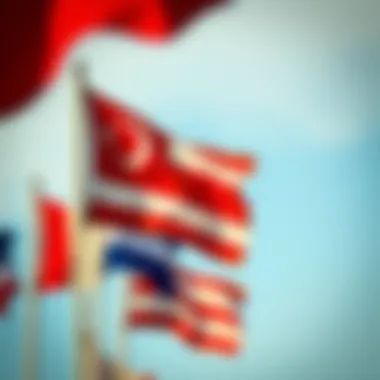

The effectiveness of racing pennants can be attributed to their bright colors and distinct shapes, allowing them to be easily spotted amidst the hustle and bustle of competitive environments. However, it’s important to note that miscommunication regarding racing flags can lead to confusion and disqualification, thus reinforcing the need for awareness and understanding of their usage among participants.
Distinctive Features of Racing Pennants
Racing pennants are often characterized by unique designs that may include geometric patterns or vibrant color combinations, which not only serve practical purposes but also create visual interest during competitions. These flags can be customized to represent different events or organizations, adding a layer of personalization that reflects the culture of surfing.
Moreover, racing pennants typically incorporate features that ensure they are readable from a distance and in various conditions. This level of design consideration is significant, particularly when surfers need to gauge information at high speeds. While their distinctive visuals can set the atmosphere in an event, using them effectively requires adequate training and understanding from all involved. Misinterpretation can lead to chaos during races, negatively impacting the experience for everyone involved.
"Understanding the nuances of marine pennant flags isn't just about aesthetics; it's key to enhancing safety and promoting awareness in the surf community."
Design Elements of Marine Pennants
Understanding the design elements of marine pennants is fundamental in appreciating their role in maritime communication and surf culture. Flags are not just pieces of fabric; they are firmly rooted in history, ethos, and the very fabric of the oceanic experience. Their design serves as an expressive canvas, reflecting not merely what they signal, but how they connect individuals and communities. Elements like color and symbolism elevate the use of pennants from mere signals to meaningful artifacts of culture and tradition.
Color Significance
Colors in marine pennants are not arbitrary; each hue conveys specific messages and emotions. The significance of these color choices can influence a surfer's perception and reaction to their environment, especially in surf competitions. Each color combination has its message — red often indicates danger, while green signifies safety. This simplicity of interpretation is crucial, as it allows surfers and water enthusiasts to quickly assimilate information even in high-adrenaline situations.
Color Combinations and Their Meanings
The combinations of colors wield a certain power in expressing messages quickly. For instance, blue and white signify a safe zone, while red and black may denote warnings. These combinations create a visual language that is universally recognized by surfers. What sets these combinations apart is their clarity and immediacy. They eliminate confusion, enabling swift decision-making. However, a downside might be that overly intricate combinations can lead to misinterpretation, especially in the fast-paced environment of the ocean.
Cultural Influences on Color Choices
Cultural contexts greatly influence how colors are perceived and used. For instance, in some cultures, white symbolizes purity, while in others, it indicates mourning. This variance can lead to divergence in the usage of the same pennant. For enthusiasts in coastal regions, local traditions might dictate unique color schemes that tell a story, whether it be about heritage, local legends, or even environmental awareness. Understanding these cultural implications can deepen the appreciation for the flags that fly on surfing beaches. On the downside, outsiders might struggle to understand the nuances behind certain colors, which could possibly alienate members of the surfing community.
Symbolism in Design
Beyond colors, symbols add layers of meaning to marine pennant flags. Every shape and mark carries significance that enhances communication far beyond words. They are the universal symbols of community, safety, and environmental respect. By incorporating rich symbology, designers connect pennants with their historical narratives, telling stories that resonate with users and onlookers alike.
Geometric Patterns and Their Interpretations
Geometric patterns often tell tales of their origin, basis in maritime laws, or historic battles at sea. A simple triangle might symbolize territorial claims, while concentric circles could signify inclusive communities. Such patterns are valuable because they encapsulate complex ideas in visually appealing forms. However, a potential drawback lies in their complexity — when abstract, they may confuse rather than clarify, especially for those new to the surf culture.
Historical Symbols and their Modern Usage
Historical symbols have endured over time, finding their way onto modern pennants and surf wear. They represent traditions, honor long-lost warriors of the waves, and even sometimes just reflect nostalgic sentiments. By embedding these symbols into current designs, surfers pay homage to their predecessors. Yet, as trends evolve, some feel that these symbols risk losing their original significance, becoming mere aesthetic choices. This blend of history and modernity can foster both connection and confusion, depending on the viewer’s knowledge.
"Colors and symbols are not just part of marine flags; they are the heartbeat of the culture they represent."
Understanding the design elements of marine pennants, especially colors and symbols, offers insights into the broader surf culture and maritime practices. Through analyzing these design choices, we can appreciate not just the flags themselves, but the narratives and traditions they uphold.
Functionality of Marine Pennant Flags in Surfboarding
The functionality of marine pennant flags in surfboarding extends far beyond mere decoration; these flags play a critical role in enhancing safety and organization within the surf environment. In a sport as dynamic as surfing, effective communication is vital. Flags offer a clear and immediate way for surfers and event organizers to relay important messages without the need for voice commands, which may be lost in the sound of crashing waves.
Communication Among Surfers
Signaling Danger
One of the most significant uses of marine pennant flags is signaling danger. A flag that waves prominently in the wind can quickly draw attention to hazardous conditions, such as rip currents or large waves. When a flag is raised, it serves as an early warning system that can benefit every surfer within sight.
The key characteristic of danger flags is their visibility—they can often be spotted from afar, ensuring that all surfers are informed about potential threats before they dive into the water. This makes them a popular choice in many surfing locations. A flag signaling danger typically features bright colors like red or orange, prompting immediate recognition from surfers and lifeguards alike.
The unique feature of the danger flag lies in its ability to communicate non-verbally over expansive distances. This can be immensely advantageous because it minimizes confusion and prevents accidents that might occur from unawareness. However, one disadvantage may be that not all surfers might recognize the significance of each flag, underscoring the necessity for educational initiatives surrounding flag meanings.
Indicating Safe Areas
In contrast to danger flags, flags indicating safe areas are equally vital in guiding surfers about where to safely catch waves. Typically displayed in green or white, these flags inform surfers where conditions are optimal and encourage them to surf in designated zones. This contributes significantly to the overall safety of the environment.
The main characteristic of safe area flags is their straightforward, reassuring nature. Surfboards enthusiasts can dive into the waves without fear, allowing them to focus on enjoying their sport. It fosters a sense of community among surfers who can confidently navigate to the designated zones marked by these flags, adding to the sport’s communal atmosphere.
The unique aspect of safe area flags is their role in managing crowd flow. When surf schools and competitions are underway, these flags help organize both beginners and seasoned surfers to minimize conflicts and accidents. On the downside, if local surfers depend too heavily on these flags, they might forget to stay tuned in to changing ocean conditions, which can change drastically in moments.
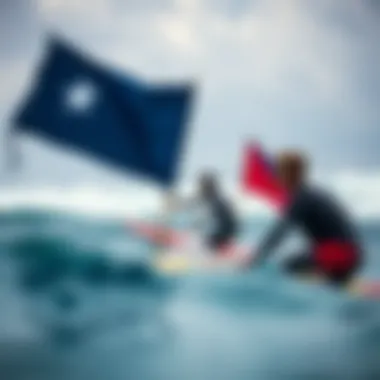
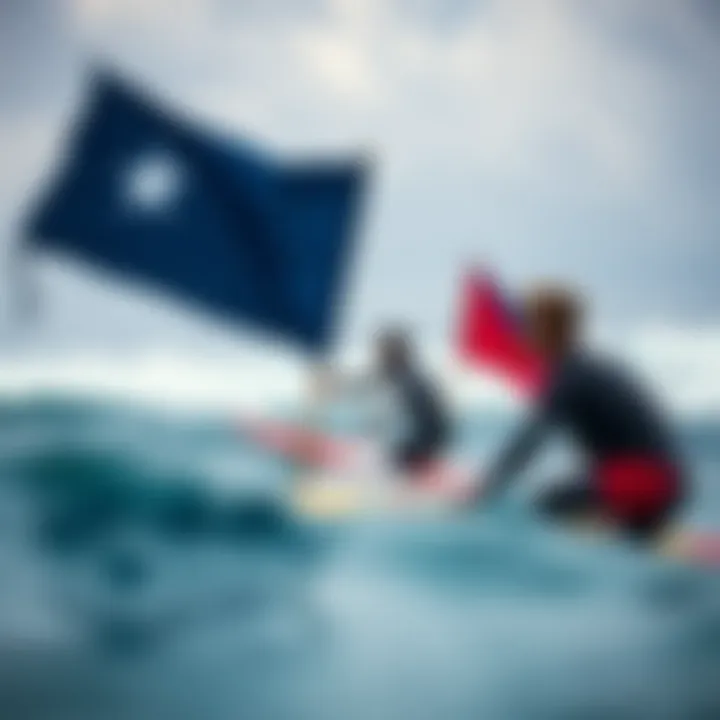
Role of Flags in Surf Competitions
Starting and Finishing Signals
In the competitive surfing arena, flags serve as crucial signals for starting and finishing heats. A raised flag can signal the start of a competition, while a different flag can indicate its conclusion. This element of flag communication is vital for maintaining the structure and timing of surf contests.
Flags used in this context tend to be brightly colored to ensure maximum attention from competitors. Its notable characteristic is its association with competition regulation, which ensures fairness and organization. These flags often become iconic symbols of the event, energizing the participants and creating an atmosphere of excitement.
The unique feature of these signals is that they enable seamless transitions between heats, which benefits both competitors and organizers. It helps keep events flowing smoothly, but an unfortunate downside could be that an unnoticed flag can lead to confusion or disqualification for competitors unaware that their heat has started or ended.
Judging Protocols
The application of flags extends into the judging protocols of surf competitions. Specific flags can signify a judging call, such as whether a wave is to be counted toward a surfer's score. This critical role ensures that competitors have a clear understanding of how their performances are evaluated.
Judging flags often correspond with specific decisions made by officials, reflecting their commitment to maintaining discipline and fairness in competitions. The distinguishing feature of these flags is that they add another layer of clarity in a sport where split-second decisions can affect outcomes.
However, one potential disadvantage is that the complexity of judging flags might confuse inexperienced competitors or audience members, who may not fully grasp the implications of different flags in play. To address this, clear communication regarding flag meanings should be part of any surf competition's preparations, ensuring everyone involved understands their significance.
In summary, marine pennant flags are not just ornamental, they are functional tools that enhance communication and safety in the surfboarding community. Their various uses—from signaling danger to enhancing competition—highlight their vital role in the surfing environment.
Regulatory Framework Surrounding Marine Flags
Understanding the regulatory framework that governs marine pennant flags is essential for anyone engaged in marine activities, especially surfers who utilize these flags for safety and communication. The rules surround both international and local regulations, ensuring that flags are used correctly, serving their intended purpose, and maintaining a level of safety on the water.
The importance of these regulations cannot be overstated. They provide a standardized method of communication across different countries and regions, thereby minimizing confusion and enhancing safety. In instances where surfers or crews are working in international waters or different locales, understanding these regulations can potentially save lives.
International Regulations
Overview of the International Code of Signals
The International Code of Signals, often referred to as the ICS, is a robust system used worldwide. This set of codes standardizes the meaning of various flags and signals, paving the way for clear communication among vessels and shore facilities regardless of language barriers. Its contribution to maritime safety and efficiency is significant. The ICS is a beneficial choice in this article due to its comprehensive nature and global recognition. It covers an array of signaling needs, including distress, navigation, and operational messages.
One unique feature of the ICS is its use of the phonetic alphabet alongside flags, enhancing clarity during situations that require precise communication. However, its complexity can pose challenges for novice users who may find themselves overwhelmed by the extensive list of flags and their meanings. Nonetheless, the advantages it offers in preventing misunderstandings are numerous, particularly in complex environments like surf competitions.
Compliance for Surf Events
Compliance for surf events regarding the use of marine pennant flags ensures that competitors and spectators alike adhere to established safety protocols. This aspect is vital because it reinforces the importance of organized surfing events which often attract a multitude of participants and viewers. A key benefit of compliance is its role in establishing a uniform set of signals understood by all involved, from competitors to event organizers.
The unique feature of this compliance is that it often aligns with broader international standards while allowing for local adaptations pertinent to specific conditions, such as waves or wind. This flexibility is vital as surf conditions can vary dramatically across locations. However, the downside could be the potential for confusion if local adaptations are not communicated effectively to all participants.
Local Regulations
National Variances in Flag Use
National variances in flag use reflect the diverse cultural and environmental contexts in which surfing takes place. Each country may have its specific rules and regulations concerning marine pennant flags, affecting everything from colors to symbols. This aspect enriches the article by showing how local traditions can influence what flags signify in different regions.
A significant characteristic of national variances is their adaptability; flags might symbolize various warnings or communications depending on local conditions, such as rip currents or marine wildlife. This localized meaning can enhance awareness and safety. However, this variability can lead to misinterpretation among surfers unfamiliar with the local practices, making education vital.
Enforcement Policies
Enforcement policies regarding the use of marine pennant flags are critical for maintaining safety standards and ensuring that surfers follow regulations during competitions or casual surfing. Establishing policies provides a framework within which flags must be recognized and adhered to. The enforcement of these policies promotes accountability and respect for maritime rules.
One notable feature of enforcement policies is the collaboration between local surf organizations and governmental bodies. This partnership can create tailored enforcement strategies that suit specific local conditions and surfing environments. However, there might be drawbacks, such as uneven enforcement, which can lead to gaps in safety or confusion among surfers.
Understanding the regulatory landscape surrounding marine pennant flags is crucial for safety and effective communication, ensuring participants in marine activities operate within a recognized framework.
As surfers engage across the globe, keeping abreast of these regulations empowers them to navigate the water safely, respecting both the sport and its environment.
Cultural Significance of Marine Pennant Flags
The presence of marine pennant flags stretches beyond mere aesthetic appeal or practical function. These flags serve as cultural artifacts that embody the spirit of surfing communities and advocate for marine environmental consciousness. As integral parts of surf culture, they tell stories, represent values, and inspire a deeper connection with the ocean. The significance of these flags rests not only in their visual designs and uses but also in their ability to unite communities and raise awareness.
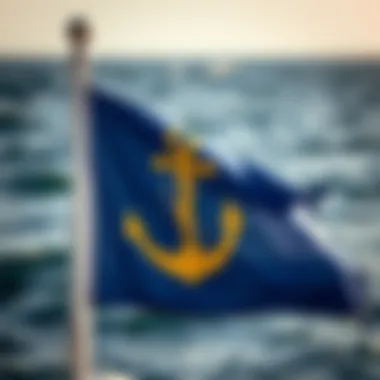
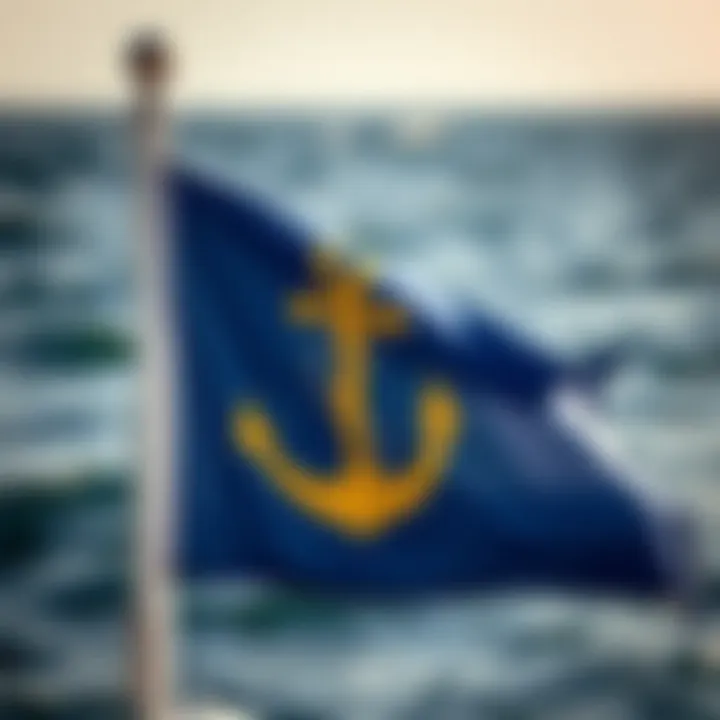
Traditions in Surf Culture
Historical Surf Communities and Flags
Historical surf communities have long recognized flags as significant icons of their culture. Each flag often tells a story rooted in local lore, with designs that reflect the collective identity of surfers alongside their waves. Historically, these flags symbolized safe spaces where surfers could gather, share knowledge, and ride together, standing as beacons of friendship in the vast ocean. For instance, the iconic triangular flags of Hawaii carry the essence of Aloha, promoting unity among ocean-goers.
These flags possess a key characteristic of being deeply tied to the identity and heritage of surfing groups. They often become a focal point during local surfing competitions and festivals, emphasizing a sense of shared history. Their designs can also depict local wildlife, waves, or cultural symbols unique to the region. The beneficial aspect of using these flags is their role in preserving stories and traditions that may otherwise fade over time.
Additionally, while they are mostly revered, there can be disadvantages. Some designs might perpetuate exclusivity rather than inclusivity. Balancing tradition with modern interpretations can be tricky, as some surfers feel a connection to historical flags while others may find them less representative of the current surfing community.
Modern Reinterpretations in Art and Fashion
As surf culture evolves, so do the interpretations of marine pennant flags. Designers have taken these symbols and woven them into art and fashion to reflect contemporary ideas and values. Now, flags often appear as prints on surfboards, clothing, and even tattoos, showcasing a blend of aesthetic and message that resonates with younger surfers. This modern take connects the vibrancy of flag colors and designs with personal identity and self-expression.
A defining feature of these modern interpretations is their playful creativity, allowing for experimentation that breaks from tradition while honoring the original symbolism. This beneficial aspect of transformation is that it invites a broader audience to engage with surf culture, having a creative outlet that encourages conversations about ocean conservation and lifestyle.
However, one must tread carefully with this innovation. While trends can create visibility, there is the risk of diluting the flags’ original significance in favor of commercial appeal. What was once a marker of community may become just another fashion statement, potentially overshadowing the deeper meaning tied to ocean stewardship and tradition.
Influence on Marine Environmental Awareness
Flags as Symbols for Conservation Efforts
Beyond surf culture's traditions, marine pennant flags also act as powerful symbols for conservation. Many surf organizations and non-profits use flags to raise awareness about the importance of preserving marine environments. Each flag can be painted with logos or messages highlighting ongoing conservation campaigns. This specific aspect of flags allows individuals to demonstrate their commitment to eco-friendly practices while riding the waves.
A notable characteristic of using flags for these efforts is their visibility—flags are hard to miss fluttering against the horizon, calling surfers and beachgoers alike to pay attention to critical issues. This connection to conservation helps invigorate community spirit and strengthens advocacy through collective action. The advantages of employing marine pennant flags for environmental awareness are profound, often leading to increased participation in local conservation initiatives.
The downside, however, may come from the potential for flag fatigue, where constant exposure to similar conservation messages can cause people to overlook important issues. It becomes essential to keep content fresh and relatable.
Awareness Campaigns in Surfing Communities
Finally, awareness campaigns within surfing communities often utilize marine pennant flags in innovative ways to draw attention. Through events like beach clean-ups and surf competitions, organizers will raise flags to signify their commitment to environmental stewardship. By painting flags with environmental themes or messages, they engage surfers in a dialogue about ocean health, pollution, and sustainability.
The prominent feature of these campaigns is their engaging nature, offering participants both fun and purpose. They foster community involvement, creating a network of surf enthusiasts who care for the ocean. This beneficial aspect creates a blend of recreation and activism that resonates deeply with many surfers.
However, challenges lie in ensuring that the campaigns remain inclusive, inviting all surfers to get involved, regardless of their skill level. If campaigns are perceived as elitist, it may reduce overall participation and weaken the communal bond.
"Flags serve more than their immediate function; they embody our collective histories, values, and responsibilities toward the ocean we cherish."
As marine pennant flags continue to evolve, their cultural significance in surf communities remains vital. They reflect the deep-rooted traditions and modern shifts while advocating for essential environmental considerations. The flags, once simple markers of signal, have transformed into powerful beacons of heritage and sustainability.
Ending and Future Perspectives
The exploration of marine pennant flags is a tapestry woven with history, utility, and cultural relevance. This article has journeyed through their origins, their roles in communication among surfers, and how they symbolize various aspects of maritime life. Understanding this topic is crucial not only for enhancing the surfing experience but also for preserving the ethos of surf culture itself. As we delve into the conclusions drawn from our findings, it’s essential to spotlight several key elements that underline the importance of marine pennant flags in contemporary settings.
Summary of Key Insights
Marine pennant flags serve multifaceted purposes. They function as communication tools, ensure safety in water sports, and carry deep-seated cultural significance. Here are a few pivotal insights:
- Communication: Flags provide a formidable way for surfers and beachgoers to communicate, signaling everything from danger to the presence of lifeguards.
- Cultural Ties: Many surf communities embrace these flags, using them as a bridge to connect with their maritime heritage.
- Regulatory Importance: Understanding the international and local regulations surrounding marine pennant flags is vital for safety and compliance during surf competitions.
"The colors and designs of these flags are not just ornamental; they embody meanings that connect generations of surfers to the ocean realm."
These insights weave a narrative emphasizing how essential marine pennant flags are, not just in the realm of surfing and competitions, but heralding larger themes of safety, communication, and cultural identity.
Looking Ahead: The Future of Marine Pennant Flags in Surfboarding
Looking forward, the role of marine pennant flags in surfboarding appears poised for transformation. As surf culture evolves, so too will the design and application of these flags. Several factors are at play:
- Technological Integration: With advancements in technology, we might see digital portrayals of traditional flag signals, such as augmented reality views that allow for quick comprehension of messages while in the water.
- Sustainability: As environmental concerns continue to rise, there may be a shift toward eco-friendly materials for flag production, inspiring a new wave that aligns with surfers’ conservation ethos. Eco-conscious flags could become symbols of a community committed to protecting the marine environment.
- Artistic Evolution: Artists, surfers, and designers are likely to collaborate more closely to create flags that reflect personal and communal identities, potentially leading to a rich mosaic of custom designs adorning beaches worldwide.
In summation, marine pennant flags stand at the intersection of tradition and innovation. They carry a legacy that endures even as the dynamics of surfing and coastal life change. Embracing the future while honoring the past will be key for maintaining the significance of these vibrant symbols in the surf community.
Thus, as we finish our deeper look into marine pennant flags, it becomes clear that while they may flutter in the wind, their essence will forever resonate within the hearts of surfers, ensuring their relevance for generations to come.
For further reading on this topic, consider visiting these resources:
Engaging with these materials can provide additional context and broaden the understanding of marine pennant flags.



